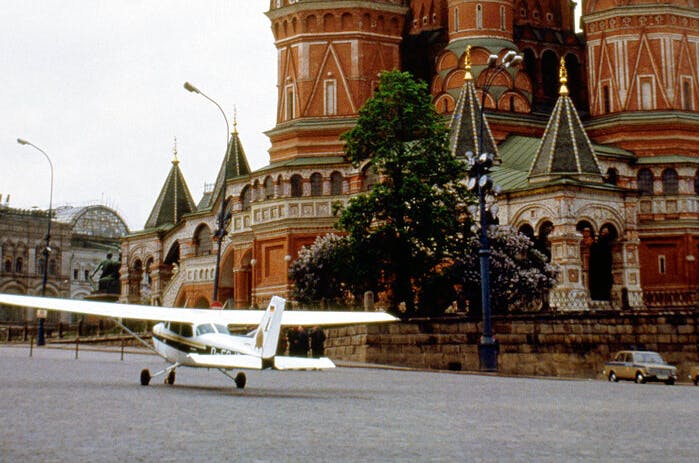Ukraine Rockets Hit Russia in a Reminder of Kyiv’s Tech Prowess
The failure of Russian air defense to protect an air base where nuclear weapons are stored in bunkers may be this generation’s Mathias Rust moment.

Clipping the wings of the mobile artillery rocket launchers sent to Ukraine, the Biden Administration made hardware and software fixes to prevent rockets from reaching Russia. American officials apparently forgot that in the Soviet era, Ukrainian engineers had designed and built ICBM rockets capable of hitting New York.
This Cold War scientific legacy resurfaced this week when Ukrainian drones flew as far as 500 miles into Russia, hitting three military bases. The biggest damage was at Engels-2 air base where two heavy bombers were taken out of action Monday morning.
Two hours after the raid, surviving Tupolev bombers took off from Engels, flew to the Ukraine border, and fired 70 cruise missiles at Ukrainian power plants. Facing what was the eighth wave of missile attacks on its infrastructure, Ukraine’s air defense claims to have shot down 60 rockets — an 85 percent kill ratio.
The failure of Russian air defense to protect an air base where nuclear weapons are stored in bunkers may be this generation’s Mathias Rust moment. Mr. Rust was an 18-year-old West German amateur pilot who, in 1987, flew through hundreds of miles of Soviet air defenses to land his rented Cessna on a bridge near Red Square.
Mikhail Gorbachev seized on this fiasco to fire his hardline Defense Minister and hundreds of other officers in the biggest military shakeup since Stalin’s purges 50 years earlier.
This time around, President Putin merely boosted “internal security” following an emergency meeting Tuesday of his national security council. No major purge seems to be in the works. Instead, Kremlin propaganda is in overdrive, trying to minimize Ukraine’s technical feats.
Russia immediately said the attacks were carried out by Soviet-era Tupolev Tu-141 “Strizh” — or “Swift” — jet reconnaissance drones reconfigured to carry warheads on one-way kamikaze missions. First manufactured in Soviet Ukraine half a century ago, these drones can indeed be seen at Kyiv – on static displays exposed to the sun and rain at the National Aviation Museum.
Russia’s military bloggers neglected to mention that on November 24 Ukraine’s state weapons producer Ukroboronprom posted on Facebook that it is testing a new strike drone with a range of up to 600 miles and a payload of 165 pounds.
On Sunday, the day before two Russian air bases were hit, the company said it had completed testing. With that range, virtually any military site in European Russia is now a target. On Monday, the second heavy bomber air base hit was near Ryazan, 125 miles southeast of Moscow.
“The attacks are repeatable. We have no limitation on distance and soon we will be able to reach all targets inside Russia — including in Siberia,” a Ukrainian government defense adviser in Kyiv tells The Financial Times. “In Ukraine, we know how hard it is to defend against these kinds of air attacks. Soon Russia will also have no safe zones.”
Failing on the battlefield, Mr. Putin has resorted to firing waves of cruise missiles and drones into Ukraine, aiming to deprive millions of people this winter of heat, water, and electricity. Recent nighttime NASA satellite photos show his handiwork. Moscow glows bright and white. Ukraine is a black hole.
Many of Ukraine’s Western supporters seemed to think that Ukraine would turn the other cheek, limiting itself to replacing power substations only to see them bombed again. Instead, Ukraine’s government has decided to go to the source of the attacks – Tupolev bombers that can carry up to five cruise missiles.
Britain’s Defense Ministry said Russia should view Ukraine’s long-distance attacks “as some of the most strategically significant failures of force protection since its invasion of Ukraine.”
After Ukraine’s long-range attacks, Secretary of State Blinken told reporters that the Biden Administration has “neither encouraged nor enabled” Kyiv to strike inside Russian territory.
The challenge for Russia is that its air defense systems are stretched thin, trying to patrol a 500-mile-long front line in Ukraine. If Russia cannot protect air bases designed for nuclear capable bombers, one solution may be to disperse its strategic bomber fleet among smaller bases.
“This is a serious and imminent problem for the Russian Defense Ministry,” the founder of the Tblisi-based Conflict Intelligence Team, Ruslan Leviev, said in a video briefing. “Ideally they’d need to put more air defense systems, but the problem both Russia and Ukraine face is that they have a finite number of these.”
The other challenge for Russians is to take Ukrainians’ technological prowess seriously.
NASA does. Last year, to develop exploration technologies for Artemis Commercial Moon Delivery in 2023, it awarded $93 million in contracts to Firefly Aerospace, an American company backed by an R&D division with 150 engineers at Dnipro.
Separately at Dnipro, Pivdenmash builds engines for Antares rockets to deliver NASA’s commercial cargo to the International Space Station. The European Space Agency uses Pivdenmash engines to power its Vega rockets launched from French Guiana.
Elon Musk has said that, after his own rockets, Pivdenmash’s Zenit rockets are “the best in the world.”

